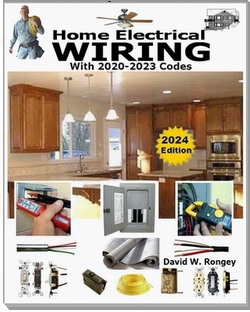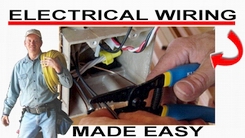» How to Wire Light Fixtures
» Need Electrical Help? Ask the Electrician
The Best Locations for Recessed Lights

|
Summary: Options for placing and installing recessed lighting: Wall wash recessed lighting for a special room, Kitchen recessed lighting for a clean appearance, Above window recessed lighting brightens up the day, Hallway recessed lighting provides a safe passageway, Fireplace recessed lighting will add extra warmth and glow. © By: Dave Rongey |
How to Plan the Ideal Location for Recessed Light Fixtures
Recessed lighting has come a long way from being found mainly in closets and hallways.
Now recessed lighting can be found in most all newly constructed homes and in almost every room.
With new technologies in lighting available today styles are available that will contribute toward energy efficiency and provide several choices that will serve as a green energy alternative.
What you should know about recessed lighting for your home |
|
| Your selection of the size and type of recessed lighting will be a factor on the amount of light that is produced and the appearance of the light not only for the room but the contents of the room as well. This is why you will find recessed lighting in special applications such as theater hallways, restaurants, retail stores and even bathrooms. A variety of sizes, levels of light produced and style of the fixture trim will have allot to do with the overall appearance of the space being illuminated. |  |
Option 1 - Wall wash recessed lighting for a special room |
|
 |
The basics of recessed lighting involve planning out the type of lighting you wish to have. The type of light that will be produced will depend on the location of the recessed lighting placement and how close the fixtures are installed to a wall. |
Option 2 - Kitchen recessed lighting for a clean appearance |
|
 |
Some types of recessed lighting will produce a different type of appearance and type of light that is cast down onto the area to be covered with light. Kitchen ceiling light fixtures may require brighter task lighting than a softer accented lighting location. |
Option 3 - Above window recessed lighting brightens up the day |
|
 |
Understanding recessed lighting will help you in the selection process especially when you have a special area in mind that will require a certain style of mood lighting that is desired. Adding a dimmer switch will allow you to obtain the exact level of light as well. Expanded lighting controls options offer remote control for your convenience. |
Option 4 - Hallway recessed lighting provides a safe passageway |
|
 |
Considerations for recessed lighting don't have to be complicated, however they do require careful consideration. Recessed lighting can be installed in harmony with solar tube lighted areas to add light during cloudy days or evening time. |
Option 5 - Fireplace recessed lighting will add extra warmth and glow |
|
 |
The recessed lighting placement can produce ambiance and will add value to any room of your home. Recessed lighting is a great way to upgrade and improve any home and will always provide a new look and appearance. |
| Typical Labor and materials to install recessed lighting will depend upon the layout of the room and accessibility not only inside the room but also in the attic area as well. The scope of the project should be planned out and the materials determined with an agreed upon price and signed contract before the job begins. |
|
| 410-66 Lighting Fixtures recessed lighting fixtures Recessed lighting fixtures installed in insulated ceilings or installed within 1/2inch of combustible material shall be approved for insulation contact and labeled Type IC. |
NOTE: This is a partial list of electrical codes. Other codes may apply. Some codes may be updated. See the Electrical Code area for more information: Home Electrical Codes |
| Large Straight-Slot Screw Driver, Medium Straight-Slot Screw Driver, Small Straight-Slot Screw Driver, Awl, Lineman's Pliers, Needle-Nose Pliers, Crimp Pliers, Wire Strippers, Sheath Knife, Black Electrical Tape, Red Electrical Tape, White Electrical Tape, Green Electrical Tape, Yellow Wire Connectors, Red Wire Connectors, Ground Crimps, Claw Hammer, Volt Tester, Pencil Marker | Romex wire, staples, wire connectors, |
The electrical tools for each project may be different depending on the individual project requirements and the access to install electrical devices. More about Electrical Tools |
The electrical parts list will depend upon each individual project and the requirements to wire specific devices added to the project. More about Electrical Parts |
|
|||||||
|
The Safest Way to Test Electrical Devices and Identify Electric Wires!The Non-Contact Electrical TesterThis is a testing tool that I have had in my personal electrical tool pouch for years, and is the first test tool I grab to help identify electrical wiring. It is a Non-contact tester that I use to easily Detect Voltage in Cables, Cords, Circuit Breakers, Lighting Fixtures, Switches, Outlets and Wires. Simply insert the end of the tester into an outlet, lamp socket, or hold the end of the tester against the wire you wish to test. Very handy and easy to use.
The Quickest Way to Check for Faulty Electrical Wiring!The Plug-In Outlet TesterThis is the first tool I grab to troubleshoot a problem with outlet circuit wiring. This popular tester is also used by most inspectors to test for power and check the polarity of circuit wiring. It detects probable improper wiring conditions in standard 110-125 VAC outlets Provides 6 probable wiring conditions that are quick and easy to read for ultimate efficiency Lights indicate if wiring is correct and indicator light chart is included Tests standard 3-wire outlets UL Listed Light indicates if wiring is incorrect Very handy and easy to use.
Strip Off Wire Insulation without Nicking and Damaging the Electric Wire!The Wire Stripper and Wire CutterMy absolute favorite wire stripping tool that I have had in my personal electrical tool pouch for years, and this is the tool I use to safely strip electrical wires. This handy tool has multiple uses: The wire gauges are shown on the side of the tool so you know which slot to use for stripping insulation. The end of the tool can be used to grip and bend wire which is handy for attaching wire onto the screw terminals of switches and outlets.. The wire stripper will work on both solid and stranded wire. This tool is Very Handy and Easy to Use. |
||
Residential Electrical Parts and AccessoriesLight Switches 120volt Outlets Circuit Breakers Electrician Tools Voltage Testers |















